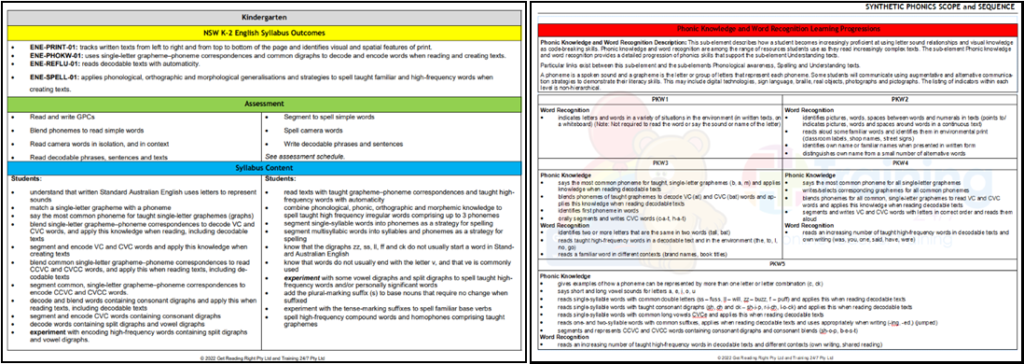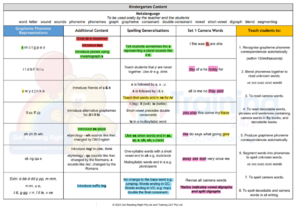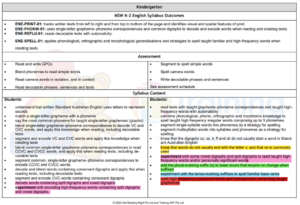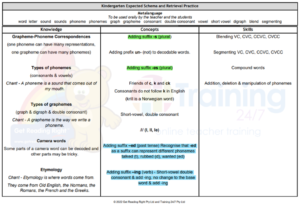Get Reading Right Updated Scope and Sequence for the new NSW K-2 English Syllabus
By Justin Caban
7 Nov 2022
Since the early drafts of the NSW English K-2 syllabus, we have been bombarded by NSW teachers and leaders with questions around phonics and the new curriculum. Many have been teachers who have used GRR resources successfully for a number of years. Early on when the syllabus was still in draft, we started to hear some concerns that teachers would have to dump everything they have designed and built and start again. Others teachers we heard from were new to phonics and looking for resources to help with new syllabus implementation. In discussion, we realised that there are many common misconceptions about the new syllabus and that an updated scope and sequence was needed to address these, and other potential concerns.
You can download the updated Get Reading Right Synthetic Phonics Scope and Sequence_NSW K-2 syllabus document we have created, and please continue reading as we walk through the changes below.
Grapheme Phoneme Correspondence (GPC) Sequence
The NSW English K-2 syllabus has a solid evidence base, and it clearly supports the Science of Reading in its reforms. One of the key components of this is that it divides the big five areas of reading instruction into separate content pages, including designated sections for phonological awareness and phonic knowledge. A sequence of which GPCs to teach when and to whom is at the heart of this evidence base. So, which sequence is the best?
The answer to this question was clearly defined in the Rose Report (2006). The report outlined that no sequence was any better than another, but reinforced the understanding that there was need for fidelity towards a chosen sequence to ensure consistency of practice and students’ success. There are many well known GPC sequences used across the world, like the Carnine sequence. You may have noticed that many publishers of decodable texts have different GPC instructional sequences; hence, the understanding that no sequence is superior to any other.
… and the NSW Syllabus sequence?
Included in the appendix of the syllabus, is a suggested instructional sequence.

As referenced, this sequence is a suggestion of the order of GPCs to be taught, for use by schools that may be introducing this concept for the first time. It is not a mandated sequence. The suggested sequence aligns to the syllabus content, but so can many other GPC sequences.
Let me show you some examples of how the GRR sequence aligns to the syllabus content through our updated scope and sequence.
Compliance Pages
There are two compliance pages for each grade in this K-2 Phonics Scope and Sequence:
Syllabus page Progressions page

Syllabus page
This compliance page is divided into three sections, which have been colour coded for your convenience.
NSW K-2 English Syllabus Outcomes (yellow)
Outcomes are mandatory statements that denote mastery at the end of a stage. Note that there are more outcomes than just the Phonic Knowledge outcome in this section (ENE-PHONKW-01). Also included are the outcomes for Print Conventions, Reading Fluency, and Spelling. There are multiple links across content areas in this syllabus, which means that a well-crafted phonics lesson can cover many components of both reading and writing instruction in the classroom.
Assessment (green)
This section clearly addresses how the outcomes will be assessed and links directly with the Progressions page (right) which tracks student achievement using the progression markers.
Syllabus Content (blue)
This section collects all the descriptors that are relevant to the outcomes listed above and links them together within this scope and sequence. It is important to note that content descriptors have always been a guide for what to teach to achieve the outcome, and they are also used to ensure consistency within the delivery of the curriculum.
An effective scope and sequence should connect the outcomes, descriptors, and the content for each grade or stage (the scope). It should show how this content is applied across grades or stages (the sequence), as students move through the novice to expert continuum.
Progressions page (red)
This outlines both the sub-element and the indictors within the range of achievement expected for the grade. After assessment, the descriptors can be used to judge a student’s achievement against a progression marker and identify areas of growth between assessment plot points.
This is useful when reporting to parents using the mandated A-E grading scale.
The final ingredient: the Content pages!
We have already discussed the fact that the suggested sequence in the syllabus is not a mandatory sequence. There is no reference to which sequence a school should choose within the syllabus outcomes or content. Therefore, some additional information is needed to ensure explicit focus areas and consistency of whole school practice.
Let me show you how this all connects together.

Content page
This page is essentially ‘what’ to teach throughout the year. It includes the knowledge, the skills, and the strategies for decoding and encoding words.
Knowledge: GPC Sequence (Blue column)
The GRR sequence contains six units of GPCs to be taught explicitly and systematically.
Units 1-3: Most common graphs (one letter) and the five short vowels.
Units 4-6: Consonant digraphs (including double consonant digraphs), and two or more representations for the same phoneme.
Skills: 8 Steps (Orange column)
Split into the four receptive skills for reading and four productive skills for spelling and writing. Mastery of the eight steps in each unit is the goal before moving on.
 Content Descriptors
Content Descriptors
The following targeted descriptors have been colour coded to show the link between the content descriptor on the syllabus page (middle), and the two content pages (above and below).
Vowel digraphs and split digraphs (pink)
This can be addressed without changing the sequence by using the cameras words. Whilst this does not cover all 30+ vowel digraphs, or all of the five split digraphs, it exposes students to the concept that graphemes come in different forms. Mastery of the most common vowel digraphs and split digraphs, as well as trigraphs and quadgraphs, continues in Year 1 and Year 2 GPC sequences.
Graphemes: v and ve (yellow)
Teach ve in Unit 3, after students have secured the graph v. Show the difference in words that begin and end in this phoneme. Follow up retrieval of this concept in the Unit 4 and Unit 5 camera words.
Plural morphographs (green)
Begin to teach plural morphograph -s in Unit 1, and identify the pronunciation change in some words. Introduce the plural morphograph -es in Unit 4, alongside graphemes like ss and zz. Continue this knowledge into Unit 5, alongside graphemes sh and ch, and in Unit 6 with x.
 Tense marking suffixes (blue)
Tense marking suffixes (blue)
Introduce -ed in Unit 3, paying particular attention to the three different pronunciations of this morphograph. Introduce -ing when students have mastered CVCC verbs, and continuing after Unit 4 by introducing doubling the consonant to add the suffix in syllables ending in _VC.
High frequency homophones (red)
These occur more in the Year 1 sequence when students are learning multiple vowel graphemes in homophones. To/too is introduced in Unit 1 as to is one of the first camera words taught. No harm in teaching two either once this mastered.
